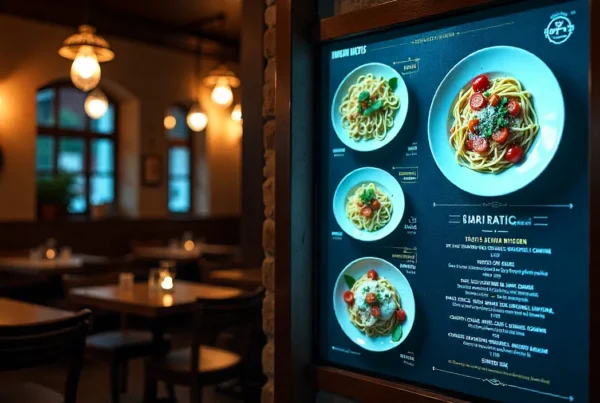The restaurant sector is currently undergoing rapid transformations because technology boosts customer satisfaction while improving operational practices. The E menu for restaurants has emerged as a digital restaurant feature that has replaced conventional paper menus. Through their ability to display digital menu boards in restaurants and use AI-based menu generation tools, e-menus create major changes in customer ordering and restaurant menu management.
This guide offers an extensive examination of e-menu order systems’ advantages and technical capabilities and system deployment alongside responses to restaurant owners’ most common questions.
What is an E menu for a restaurant?

The electronic menu, known as an e-menu, functions as a digital version of the standard restaurant menu, which operates through tablets and touchscreen kiosks or digital menu boards. Customers who experience e-menus benefit from interactive features because they can browse food images of great quality alongside nutritional facts and place orders from the menu directly.
Types of E menus for Restaurants
Different e-menu designs exist to match the requirements of various restaurants:
1. Digital Menu Boards—Show restaurant, drive-thru, and bar menus on screens that receive real-time updates.
2. QR Code-Based E menus The QR code system enables customers to access the menu through their smartphone by scanning the code.
3. Tablet-Based Menus—Provided at tables for a seamless ordering experience.
4. Self-Order Kiosks—enable customers to browse through available options and make their own orders independently from staff members.
5. AI Menu Generator Systems—Provides recommendations of menu items that align with customer requirements and their buying patterns from earlier transactions.
Benefits of Using an E menu Order System for Restaurants
Restaurants that use electronic menu ordering systems benefit their customers and operations through numerous advantages. Some key advantages include
1. Enhanced Customer Experience
• Customer choices can be easily presented by including images, videos, and detailed descriptions that will help the customer navigate through your products.
• Recommendations based on the use of artificial intelligence technology that gives a more personalized experience for the customer.
• Faster ordering through quick search and filter options.
2. Cost and Time Efficiency
• No more printing: This means that the customers and the waiters will not have to go through the stress of reprinting a menu time and again.
• Real time: The prices, seasonal foods, or a dish that has run out of stock can be changed on the fly.
• Reduction of workload: Customers order food directly, thus eliminating cases of wrong orders and time spent by the staff taking orders.
3. Increased Sales & Upselling Opportunities
• Promotions: Highlight the current promotions, dynamic prices, and other related products that can be bundled together.
• Order history: Suggest extra items or specialty dishes that the customer has ordered before.
4. Sustainability & Hygiene
• Paperless solution: It cuts down on the use of papers and therefore encourages the conservation of the environment.
• Contactless ordering: Reduces physical contact, thus improving cleanliness, especially in the current world order.
5. Data-Driven Insights
• Track popular items: The next step is to track the most ordered items so as to be able to adjust your menu.
• Peak hours: Operational changes and inventory levels should be altered according to the number of customers.

Key Features of a Modern E menu System
A modern system of electronic menus provides the restaurant owners with several features that help to manage the restaurant business and enhance the clients’ experience. Key features include
1. Cloud-Based Menu Management
• Allows the update of menus from any device.
• There is an opportunity to synchronize all the changes at the same time across the different platforms present in various locations.
2. Multi-Language Support
• To broaden its reach, it should offer options for the international audience by providing translations to a variety of clients.
3. Integration with POS & Kitchen Display Systems
• Such orders are transmitted directly to the kitchen, hence eliminating cases of conveying wrong orders or taking a long time to serve the customers.
4. Customer Feedback & Ratings
• Gather feedback from the customers to be able to enhance the services and products that are offered.
5. AI-Powered Menu Generator
• There are features of recommending dishes based on trends, seasonality, and customers’ behavior to enhance the eating experience.
How to Implement an E menu in Your Restaurant
Switching to an e-menu system in your restaurant requires careful planning through specific steps that lead to a streamlined implementation process. Here’s how to go about it:

Step 1: Choose the Right E menu System
Your first move should involve selecting an appropriate e-menu system that matches your restaurant’s type. QSR establishments benefit from digital menu boards and self-order kiosks as their optimal solutions. The fast-operating systems enable customers to view all menu options and submit their orders quickly, which drives speed through busy times. For upscale dining restaurants, a system based on tablet devices or QR code menus provides the most appropriate solution. The premium menus through tablets or QR codes enable an interactive menu viewing experience suitable for establishments that promote high-touch fine dining service.
Step 2: Design an Engaging Digital Menu
After selecting the system, you need to create an interactive digital menu that will appeal to customers. High-quality images and videos of your dishes should be used to create an engaging menu because visual appeal plays a fundamental role in attracting customers to order. Customers need to find their way through the menu easily, so the logical organization into Starters, Mains, and Dessert categories should be included. Your choice of bestsellers and chef’s recommendation sections functions as a customer guiding system that directs orders toward popular or profitable food items, thus increasing sales.
Step 3: Train Staff & Customers
The implementation process requires essential training as its main component. Staff members require training in system troubleshooting and customer usage support for the new system. Any technical problems can be handled efficiently through this approach to deliver a smooth overall experience. All customers need straightforward guidance to operate the system through both QR code scanning and tablet interactions. The e-menus become more accessible for customers through simple guidelines that provide step-by-step directions for navigation.
Step 4: Promote Your E menu
The effective promotion of your operational e-menu represents your second step after its deployment. After introducing the new system, use your social media to promote it through a tagline that says, “Scan & Order in Seconds!” This phrase will attract customer interest while motivating them to experience your new system. You should provide initial digital ordering discounts with special promotions since these incentives will push customers to try the new system while generating excitement about it.
Step 5: Monitor & Optimize
You must observe and enhance the operational performance of your e-menu system as an essential concluding step. Record order statistics together with direct feedback from customers to optimize product content and enhance the whole ordering process. The most ordered items should serve as a guide to readjust your menu display or promotional strategies. Your digital menu stays appealing to customers by performing periodic updates using performance measures and customer behavior feedback.
Upgrade Your Restaurant’s Ordering Experience Today!
Your restaurant needs an e-menu system to reach the next stage of development. Nento offers all necessary tools to help businesses implement either digital menu boards or QR-code-based systems that deliver enhanced customer experience alongside operational efficiency and sales growth.
Your restaurant can experience enhanced customer satisfaction by using Nento’s e-menu system, so start your 14-day preliminary program right now.
FAQs About E menu for Restaurants
What is the cost of implementing an e-menu system?
Different types of system technology determine the expense. The implementation cost of QR-code menus is lower than that of interactive kiosks and AI-powered systems. Cloud-based solutions charge customers through periodic monthly payments.
Can e-menus work offline?
The system lets customers access information offline yet needs an internet connection to stay updated in real time.
Are e-menus secure for payment processing?
The majority of e-menu systems use Stripe or PayPal and similar secure payment gateways to provide safe payment processing.
How do digital menu boards help with drive-thrus?
Drive-thru digital menu displays create real-time promotional and menu change presentations, which enhance order efficiency for better customer satisfaction.
Can AI really improve restaurant menus?
Absolutely! AI technology evaluates customer datasets to discover trending dishes while it optimizes prices and minimizes waste, which leads to an optimized, efficient menu concept.
Do customers prefer e-menus over traditional menus?
Younger generations, specifically including Millennials and Gen Z, strongly favor e-menus because these systems provide them with quick and convenient menu access.
How often should I update my digital menu?
Upgrades to seasonal dishes as well as new menu items must appear immediately. Your menu stays lively and connected to the times through immediate updates.





